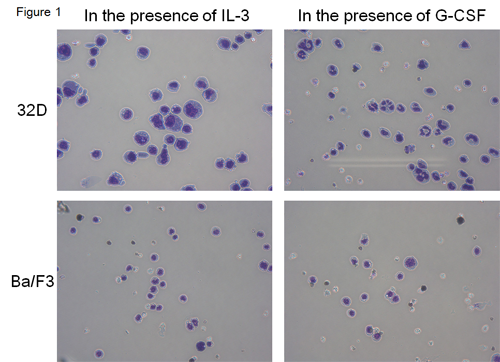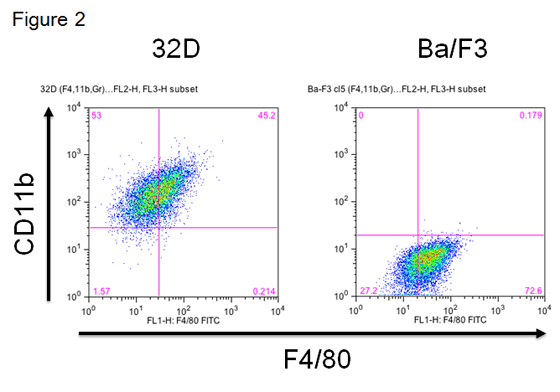The following cell lines are now available for distribution.

July, 2012 Dear User of Ba/F3 cell line,
We regret to inform you that Ba/F3 cell line (RCB0805), which we have been providing for a long time, was found to be derived from C3H mouse strain but not from BALB/c mouse strain. Ba/F3 cell line (RCB0805) was originally deposited to our cell bank in 1992 as an IL-3-dependent mouse cell line derived from BALB/c mouse strain and has been distributed since then. We previously provided this Ba/F3 cell line to DSMZ in Germany and DSMZ has also distributed this line to their users. One of the DSMZ users recently informed DSMZ that a precise SNP analysis demonstrated Ba/F3 cell line was derived from C3H mouse strain but not from BALB/c mouse strain. After receiving this information from DSMZ, we also performed the simple sequence length polymorphism (SSLP) analysis to determine the origin of Ba/F3 cell line. Our SSLP analysis confirmed that Ba/F3 cell line is the C3H mouse strain origin.
We have been providing another IL-3-dependent mouse cell line, 32D, which was derived from C3H mouse strain. To exclude the possibility of misidentification/cross-contamination of Ba/F3 with 32D, we compared the characteristics of Ba/F3 and 32D cell lines. The results are shown in Figure 1 and 2.
Figure 1. Morphological analysis.

When cultured in the presence of IL-3, the cell size of 32D cells was apparently much bigger than Ba/F3 cells. In addition, when both cell lines were cultured in the presence of G-CSF and in the absence of IL-3, 32D cells differentiated into mature myeloid cells and many segmented neutrophil-like cells were observed. In contrast, in the same condition, such segmented neutrophil-like cells were not induced from Ba/F3 cells at all, and many Ba/F3 cells lost the viability.
Figure 2. Flow cytometer analysis.
 When we stained both cell lines with CD11b (vertical axis) and F4/80 (horizontal axis), 32D cells were clearly stained with CD11b but Ba/F3 cells were not. The expression of F4/80 did not differ so much between both lines.
When we stained both cell lines with CD11b (vertical axis) and F4/80 (horizontal axis), 32D cells were clearly stained with CD11b but Ba/F3 cells were not. The expression of F4/80 did not differ so much between both lines.
In conclusion, Ba/F3 and 32D cell lines are quite different cell lines and there is no possibility that Ba/F3 is a misidentified/cross-contaminated cell line with 32D cell line.
To the best of our bibliographical search, we could identified no paper describing the establishment of Ba/F3 cell line, i.e., there is no paper demonstrating that Ba/F3 cell line was derived from BALB/c mouse strain. Although Ba/F3 cell line has been used for a long time with the belief of BALB/c origin, it is most likely that Ba/F3 cell line was derived from C3H mouse strain from very early phase of its use or from the beginning of its use in the community. We recognize that this fact may cause serious trouble to you while we hope that the trouble is the minimum. In occasions you need to report this fact to some Journal in which you published your results using Ba/F3 cells, please let us know. We will write a document explaining the situation above as the provider of the cell line Concluding remarks:
We will continue the provision of Ba/F3 cell line but as a cell line derived from C3H mouse strain.
We are now performing cloning of Ba/F3 cells and will provide the cloned line as well in the near future. A newly developed technology sometimes reveals mistake, mishandling, or misidentification that has occurred in the past and results in painful outcomes. Although the outcomes may be as painful as could be, we believe it is a necessary process for proper development of sciences. We are currently performing rigorous quality control of cell lines to serve better to the scientific community. We appreciate you for your understanding and support to our activities. If you have any question or inquiry on this matter, please feel free to contact us. With best regards.
| Sincerely yours, |
| Yukio Nakamura, M.D., Ph. D. Head Cell Engineering Division RIKEN BioResource Center E-mail: cellqa.brc |





